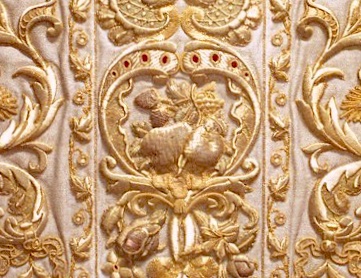The chasuble is of white silk and it utilizes a kind of embroidery called "stumpwork" or more simply embossed embroidery. Essentially it involves embroidery that is raised up or padded to give it a greater, more three dimensional quality -- in other words, these deep textures are not achieved simply by the embroiderers thread being built up. I should mention that this technique is not nineteenth century in its origins; rather it pre-dates it by quite a few centuries and can be found used toward the latter part of the middle ages. My point in mentioning that century is simply that it certainly was a popular technique in France at this point in time and everything from the cut to the Latin cross orphrey on the back point to it likely being French (or at very least produced in a workshop that was heavily French influenced.)
Also indicative of nineteenth century origins -- the second half more specifically, though it possibly could also hail from the first few decades of the twentieth as well -- are the particular symbolic inclusions. The central axis of the cross includes images of the Sacred Heart of Jesus and Immaculate Heart of Mary as well as Eucharistic motifs, wheat and grapes, can also be found. These themes were, of course, very much a part of the standard visual lexicon of that period of time -- and particularly so in places like France.
Some details (with apologies for the poor image quality):
 |
| Sacred Heart (left) and Immaculate Heart (right) |
 |
| Shafts of wheat |












